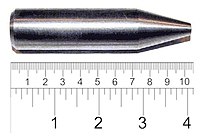
Photo from wikipedia
Background: Management of the congenitally corrected transposition of the great arteries (ccTGA) with intact ventricular septum (IVS) is controversial and includes either anatomic repair with systemic left ventricle (morphological left… Click to show full abstract
Background: Management of the congenitally corrected transposition of the great arteries (ccTGA) with intact ventricular septum (IVS) is controversial and includes either anatomic repair with systemic left ventricle (morphological left ventricle) or maintenance of a systemic right ventricle (morphological right ventricle). The purpose of this study was to describe outcomes of ccTGA-IVS with either strategy. Methods: A single-institution, retrospective review of all patients with a diagnosis of ccTGA-IVS who either underwent double switch operation (DSO) or managed with systemic morphological right ventricle (no-DSO). The composite end points included death, heart transplantation, or development of significant systemic ventricular dysfunction or atrioventricular valve regurgitation. Results: Between January 1980 and October 2019, 128 patients with ccTGA-IVS underwent primary treatment at a single institution (91 no-DSO and 37 DSO). Mean age at initial presentation was younger in the DSO compared with the no-DSO cohort (2.1 versus 18.2 years; P<0.001). Fifty patients underwent pulmonary artery banding (35 DSO and 15 no-DSO). In the no-DSO cohort, the overall mortality was 5.5% (n=5), 17.6% (n=16) developed morphological right ventricular dysfunction, and 40.7% (n=37) required pacemaker. In the DSO cohort, mortality was 2.7% (n=1), 8.1% (n=3) developed morphological left ventricular dysfunction, and 43.6% (n=16) required pacemaker. Freedom from composite end point at 5 and 10 years was 88% and 87% in the no-DSO compared with 94% and 84% in the DSO cohort. The DSO cohort had 0.29× the hazards of developing the composite outcome compared with the no-DSO cohort (hazard ratio, 0.29 [95% CI, 0.089–0.94]; P=0.039). Among patients with initial age at presentation ≤5 years, DSO was associated with 0.16× the hazard compared with no-DSO (hazard ratio, 0.16 [95% CI, 0.04–0.62]; P=0.008). Pacemaker implantation was not associated with increased hazard of the composite outcome. Conclusions: Systemic ventricular dysfunction is a late complication of ccTGA-IVS regardless of the strategy pursued. Compared with those undergoing anatomic repair, patients with systemic morphological right ventricle may have lower long-term freedom from cardiovascular complications.
Journal Title: Circulation: Cardiovascular Interventions
Year Published: 2021
Link to full text (if available)
Share on Social Media: Sign Up to like & get
recommendations!